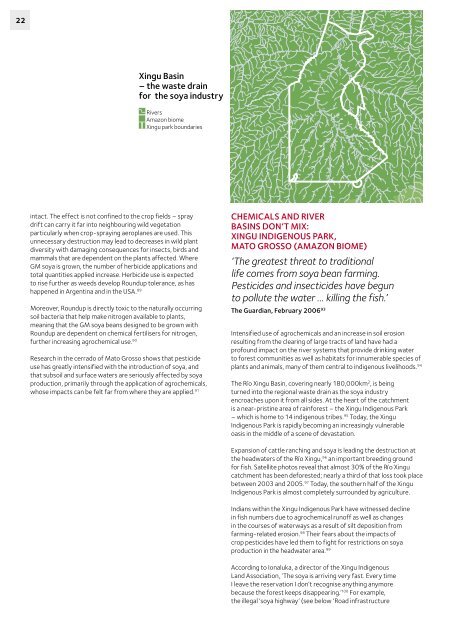EATING UP THE AMAZON 1
EATING UP THE AMAZON 1
EATING UP THE AMAZON 1
You also want an ePaper? Increase the reach of your titles
YUMPU automatically turns print PDFs into web optimized ePapers that Google loves.
22<br />
Xingu Basin<br />
– the waste drain<br />
for the soya industry<br />
Rivers<br />
Amazon biome<br />
Xingu park boundaries<br />
intact. The effect is not confined to the crop fields – spray<br />
drift can carry it far into neighbouring wild vegetation<br />
particularly when crop-spraying aeroplanes are used. This<br />
unnecessary destruction may lead to decreases in wild plant<br />
diversity with damaging consequences for insects, birds and<br />
mammals that are dependent on the plants affected. Where<br />
GM soya is grown, the number of herbicide applications and<br />
total quantities applied increase. Herbicide use is expected<br />
to rise further as weeds develop Roundup tolerance, as has<br />
happened in Argentina and in the USA. 89<br />
Moreover, Roundup is directly toxic to the naturally occurring<br />
soil bacteria that help make nitrogen available to plants,<br />
meaning that the GM soya beans designed to be grown with<br />
Roundup are dependent on chemical fertilisers for nitrogen,<br />
further increasing agrochemical use. 90<br />
Research in the cerrado of Mato Grosso shows that pesticide<br />
use has greatly intensified with the introduction of soya, and<br />
that subsoil and surface waters are seriously affected by soya<br />
production, primarily through the application of agrochemicals,<br />
whose impacts can be felt far from where they are applied. 91<br />
CHEMICALS AND RIVER<br />
BASINS DON’T MIX:<br />
XINGU INDIGENOUS PARK,<br />
MATO GROSSO (<strong>AMAZON</strong> BIOME)<br />
‘The greatest threat to traditional<br />
life comes from soya bean farming.<br />
Pesticides and insecticides have begun<br />
to pollute the water … killing the fish.’<br />
The Guardian, February 2006 93<br />
Intensified use of agrochemicals and an increase in soil erosion<br />
resulting from the clearing of large tracts of land have had a<br />
profound impact on the river systems that provide drinking water<br />
to forest communities as well as habitats for innumerable species of<br />
plants and animals, many of them central to indigenous livelihoods. 94<br />
The Río Xingu Basin, covering nearly 180,000km 2 , is being<br />
turned into the regional waste drain as the soya industry<br />
encroaches upon it from all sides. At the heart of the catchment<br />
is a near-pristine area of rainforest – the Xingu Indigenous Park<br />
– which is home to 14 indigenous tribes. 95 Today, the Xingu<br />
Indigenous Park is rapidly becoming an increasingly vulnerable<br />
oasis in the middle of a scene of devastation.<br />
Expansion of cattle ranching and soya is leading the destruction at<br />
the headwaters of the Río Xingu, 96 an important breeding ground<br />
for fish. Satellite photos reveal that almost 30% of the Río Xingu<br />
catchment has been deforested; nearly a third of that loss took place<br />
between 2003 and 2005. 97 Today, the southern half of the Xingu<br />
Indigenous Park is almost completely surrounded by agriculture.<br />
Indians within the Xingu Indigenous Park have witnessed decline<br />
in fish numbers due to agrochemical runoff as well as changes<br />
in the courses of waterways as a result of silt deposition from<br />
farming-related erosion. 98 Their fears about the impacts of<br />
crop pesticides have led them to fight for restrictions on soya<br />
production in the headwater area. 99<br />
According to Ionaluka, a director of the Xingu Indigenous<br />
Land Association, ‘The soya is arriving very fast. Every time<br />
I leave the reservation I don’t recognise anything anymore<br />
because the forest keeps disappearing.’ 100 For example,<br />
the illegal ‘soya highway’ (see below ‘Road infrastructure




![[2007] EWHC 311 - Greenpeace UK](https://img.yumpu.com/22079793/1/184x260/2007-ewhc-311-greenpeace-uk.jpg?quality=85)











